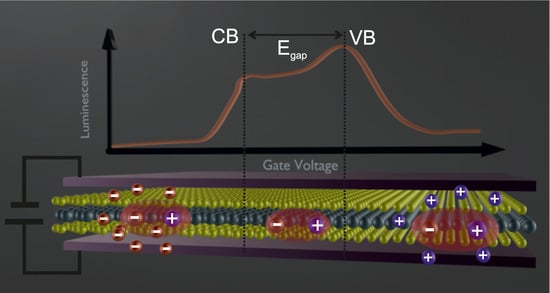Exciton Manifolds in Highly Ambipolar Doped WS2
Abstract
:1. Introduction
2. Materials and Methods
2.1. Sample Preparation and Introduction of Electrolyte Field Effect Structure
2.2. Electric Control and Functionality of the Electrolyte Gate
2.3. Spectroscopic Imaging Ellipsometry
2.4. Photoluminescence Spectroscopy
3. Results
3.1. Optically Detected Band Edges
3.2. Emission Spectra in High-Doping Regime
3.3. Doping-Dependent Dielectric Properties and Rydberg States
4. Discussion
5. Conclusions
Supplementary Materials
Author Contributions
Funding
Data Availability Statement
Acknowledgments
Conflicts of Interest
References
- Akinwande, D.; Petrone, N.; Hone, J. Two-dimensional flexible nanoelectronics. Nat. Commun. 2014, 5, 1–12. [Google Scholar] [CrossRef]
- Mak, K.F.; Shan, J. Photonics and optoelectronics of 2D semiconductor transition metal dichalcogenides. Nat. Photonics 2016, 10, 216–226. [Google Scholar] [CrossRef]
- Briggs, N.; Subramanian, S.; Lin, Z.; Li, X.; Zhang, X.; Zhang, K.; Xiao, K.; Geohegan, D.; Wallace, R.; Chen, L.Q.; et al. A roadmap for electronic grade 2D materials. 2D Mater. 2019, 6, 22001. [Google Scholar] [CrossRef]
- Bolotsky, A.; Butler, D.; Dong, C.; Gerace, K.; Glavin, N.R.; Muratore, C.; Robinson, J.A.; Ebrahimi, A. Two-dimensional materials in biosensing and healthcare: From in vitro diagnostics to optogenetics and beyond. ACS Nano 2019, 13, 9781–9810. [Google Scholar] [CrossRef]
- Michaelis de Vasconcellos, S.; Wigger, D.; Wurstbauer, U.; Holleitner, A.W.; Bratschitsch, R.; Kuhn, T. Single-Photon Emitters in Layered Van der Waals Materials. Phys. Status Solidi 2022, 259, 2100566. [Google Scholar] [CrossRef]
- Manzeli, S.; Ovchinnikov, D.; Pasquier, D.; Yazyev, O.V.; Kis, A. 2D transition metal dichalcogenides. Nat. Rev. Mater. 2017, 2, 1–15. [Google Scholar] [CrossRef]
- Zhang, C.; Johnson, A.; Hsu, C.L.; Li, L.J.; Shih, C.K. Direct imaging of band profile in single layer MoS2 on graphite: Quasiparticle energy gap, metallic edge states, and edge band bending. Nano Lett. 2014, 14, 2443–2447. [Google Scholar] [CrossRef]
- Chernikov, A.; Berkelbach, T.C.; Hill, H.M.; Rigosi, A.; Li, Y.; Aslan, O.B.; Reichman, D.R.; Hybertsen, M.S.; Heinz, T.F. Exciton binding energy and nonhydrogenic Rydberg series in monolayer WS2. Phys. Rev. Lett. 2014, 113, 076802. [Google Scholar] [CrossRef]
- Ye, Z.; Cao, T.; O’brien, K.; Zhu, H.; Yin, X.; Wang, Y.; Louie, S.G.; Zhang, X. Probing excitonic dark states in single-layer tungsten disulphide. Nature 2014, 513, 214–218. [Google Scholar] [CrossRef]
- Ugeda, M.M.; Bradley, A.J.; Shi, S.F.; Da Jornada, F.H.; Zhang, Y.; Qiu, D.Y.; Ruan, W.; Mo, S.K.; Hussain, Z.; Shen, Z.X.; et al. Giant bandgap renormalization and excitonic effects in a monolayer transition metal dichalcogenide semiconductor. Nat. Mater. 2014, 13, 1091–1095. [Google Scholar] [CrossRef] [Green Version]
- Ye, J.; Zhang, Y.J.; Akashi, R.; Bahramy, M.S.; Arita, R.; Iwasa, Y. Superconducting dome in a gate-tuned band insulator. Science 2012, 338, 1193–1196. [Google Scholar] [CrossRef]
- Costanzo, D.; Zhang, H.; Reddy, B.A.; Berger, H.; Morpurgo, A.F. Tunnelling spectroscopy of gate-induced superconductivity in MoS2. Nat. Nanotechnol. 2018, 13, 483–488. [Google Scholar] [CrossRef]
- Piatti, E.; De Fazio, D.; Daghero, D.; Tamalampudi, S.R.; Yoon, D.; Ferrari, A.C.; Gonnelli, R.S. Multi-valley superconductivity in ion-gated MoS2 layers. Nano Lett. 2018, 18, 4821–4830. [Google Scholar] [CrossRef]
- Lu, J.; Zheliuk, O.; Chen, Q.; Leermakers, I.; Hussey, N.E.; Zeitler, U.; Ye, J. Full superconducting dome of strong Ising protection in gated monolayer WS2. Proc. Natl. Acad. Sci. USA 2018, 115, 3551–3556. [Google Scholar] [CrossRef]
- Miller, B.; Lindlau, J.; Bommert, M.; Neumann, A.; Yamaguchi, H.; Holleitner, A.; Högele, A.; Wurstbauer, U. Tuning the Fröhlich exciton-phonon scattering in monolayer MoS2. Nat. Commun. 2019, 10, 1–6. [Google Scholar] [CrossRef]
- Raja, A.; Selig, M.; Berghäuser, G.; Yu, J.; Hill, H.M.; Rigosi, A.F.; Brus, L.E.; Knorr, A.; Heinz, T.F.; Malic, E.; et al. Enhancement of exciton–phonon scattering from monolayer to bilayer WS2. Nano Lett. 2018, 18, 6135–6143. [Google Scholar] [CrossRef]
- Malic, E.; Selig, M.; Feierabend, M.; Brem, S.; Christiansen, D.; Wendler, F.; Knorr, A.; Berghäuser, G. Dark excitons in transition metal dichalcogenides. Phys. Rev. Mater. 2018, 2, 014002. [Google Scholar] [CrossRef]
- Niehues, I.; Schmidt, R.; Druppel, M.; Marauhn, P.; Christiansen, D.; Selig, M.; Berghaäuser, G.; Wigger, D.; Schneider, R.; Braasch, L.; et al. Strain control of exciton–phonon coupling in atomically thin semiconductors. Nano Lett. 2018, 18, 1751–1757. [Google Scholar] [CrossRef]
- Raja, A.; Chaves, A.; Yu, J.; Arefe, G.; Hill, H.M.; Rigosi, A.F.; Berkelbach, T.C.; Nagler, P.; Schüller, C.; Korn, T.; et al. Coulomb engineering of the bandgap and excitons in two-dimensional materials. Nat. Commun. 2017, 8, 1–7. [Google Scholar] [CrossRef]
- Kajino, Y.; Oto, K.; Yamada, Y. Modification of optical properties in monolayer WS2 on dielectric substrates by coulomb engineering. J. Phys. Chem. C 2019, 123, 14097–14102. [Google Scholar] [CrossRef]
- Chernikov, A.; Ruppert, C.; Hill, H.M.; Rigosi, A.F.; Heinz, T.F. Population inversion and giant bandgap renormalization in atomically thin WS 2 layers. Nat. Photonics 2015, 9, 466–470. [Google Scholar] [CrossRef]
- Chernikov, A.; Van Der Zande, A.M.; Hill, H.M.; Rigosi, A.F.; Velauthapillai, A.; Hone, J.; Heinz, T.F. Electrical tuning of exciton binding energies in monolayer WS2. Phys. Rev. Lett. 2015, 115, 126802. [Google Scholar] [CrossRef]
- He, X.; Zhang, Z.; Zhang, C.; Yang, Y.; Hu, M.; Ge, W.; Zhang, X. Exploration of exciton behavior in atomically thin WS2 layers by ionic gating. Appl. Phys. Lett. 2018, 113, 013104. [Google Scholar] [CrossRef]
- Qiu, Z.; Trushin, M.; Fang, H.; Verzhbitskiy, I.; Gao, S.; Laksono, E.; Yang, M.; Lyu, P.; Li, J.; Su, J.; et al. Giant gate-tunable bandgap renormalization and excitonic effects in a 2D semiconductor. Sci. Adv. 2019, 5, eaaw2347. [Google Scholar] [CrossRef]
- Ulstrup, S.; Cabo, A.G.; Miwa, J.A.; Riley, J.M.; Grønborg, S.S.; Johannsen, J.C.; Cacho, C.; Alexander, O.; Chapman, R.T.; Springate, E.; et al. Ultrafast band structure control of a two-dimensional heterostructure. ACS Nano 2016, 10, 6315–6322. [Google Scholar] [CrossRef]
- Bao, D.; Del Águila, A.G.; Do, T.T.H.; Liu, S.; Pei, J.; Xiong, Q. Probing momentum-indirect excitons by near-resonance photoluminescence excitation spectroscopy in WS2 monolayer. 2D Mater. 2020, 7, 031002. [Google Scholar] [CrossRef]
- Qin, M.; Han, X.; Ding, D.; Niu, R.; Qu, Z.; Wang, Z.; Liao, Z.M.; Gan, Z.; Huang, Y.; Han, C.; et al. Light Controllable Electronic Phase Transition in Ionic Liquid Gated Monolayer Transition Metal Dichalcogenides. Nano Lett. 2021, 21, 6800–6806. [Google Scholar] [CrossRef]
- Suh, J.; Park, T.E.; Lin, D.Y.; Fu, D.; Park, J.; Jung, H.J.; Chen, Y.; Ko, C.; Jang, C.; Sun, Y.; et al. Doping against the native propensity of MoS2: Degenerate hole doping by cation substitution. Nano Lett. 2014, 14, 6976–6982. [Google Scholar] [CrossRef]
- Mouri, S.; Miyauchi, Y.; Matsuda, K. Tunable photoluminescence of monolayer MoS2 via chemical doping. Nano Lett. 2013, 13, 5944–5948. [Google Scholar] [CrossRef]
- Fang, H.; Tosun, M.; Seol, G.; Chang, T.C.; Takei, K.; Guo, J.; Javey, A. Degenerate n-doping of few-layer transition metal dichalcogenides by potassium. Nano Lett. 2013, 13, 1991–1995. [Google Scholar] [CrossRef]
- Gutiérrez-Lezama, I.; Ubrig, N.; Ponomarev, E.; Morpurgo, A.F. Ionic gate spectroscopy of 2D semiconductors. Nat. Rev. Phys. 2021, 3, 508–519. [Google Scholar] [CrossRef]
- Fullerton-Shirey, S.K.; Maranas, J.K. Effect of LiClO4 on the Structure and Mobility of PEO-Based Solid Polymer Electrolytes. Macromolecules 2009, 42, 2142–2156. [Google Scholar] [CrossRef]
- Steinhoff, A.; Florian, M.; Rösner, M.; Schönhoff, G.; Wehling, T.O.; Jahnke, F. Exciton fission in monolayer transition metal dichalcogenide semiconductors. Nat. Commun. 2017, 8, 1–11. [Google Scholar] [CrossRef]
- Zinkiewicz, M.; Wozniak, T.; Kazimierczuk, T.; Kapuscinski, P.; Oreszczuk, K.; Grzeszczyk, M.; Bartos, M.; Nogajewski, K.; Watanabe, K.; Taniguchi, T.; et al. Excitonic complexes in n-doped WS2 monolayer. Nano Lett. 2021, 21, 2519–2525. [Google Scholar] [CrossRef]
- Madéo, J.; Man, M.K.; Sahoo, C.; Campbell, M.; Pareek, V.; Wong, E.L.; Al-Mahboob, A.; Chan, N.S.; Karmakar, A.; Mariserla, B.M.K.; et al. Directly visualizing the momentum-forbidden dark excitons and their dynamics in atomically thin semiconductors. Science 2020, 370, 1199–1204. [Google Scholar] [CrossRef]
- Wallauer, R.; Perea-Causin, R.; Münster, L.; Zajusch, S.; Brem, S.; Güdde, J.; Tanimura, K.; Lin, K.Q.; Huber, R.; Malic, E.; et al. Momentum-resolved observation of exciton formation dynamics in monolayer WS2. Nano Lett. 2021, 21, 5867–5873. [Google Scholar] [CrossRef]
- Arora, A.; Wessling, N.K.; Deilmann, T.; Reichenauer, T.; Steeger, P.; Kossacki, P.; Potemski, M.; de Vasconcellos, S.M.; Rohlfing, M.; Bratschitsch, R. Dark trions govern the temperature-dependent optical absorption and emission of doped atomically thin semiconductors. Phys. Rev. B 2020, 101, 241413. [Google Scholar] [CrossRef]
- Miller, B.; Parzinger, E.; Vernickel, A.; Holleitner, A.W.; Wurstbauer, U. Photogating of mono-and few-layer MoS2. Appl. Phys. Lett. 2015, 106, 122103. [Google Scholar] [CrossRef]
- Petach, T.A.; Lee, M.; Davis, R.C.; Mehta, A.; Goldhaber-Gordon, D. Mechanism for the large conductance modulation in electrolyte-gated thin gold films. Phys. Rev. B 2014, 90, 081108. [Google Scholar] [CrossRef]
- Braga, D.; Gutierrez Lezama, I.; Berger, H.; Morpurgo, A.F. Quantitative determination of the band gap of WS2 with ambipolar ionic liquid-gated transistors. Nano Lett. 2012, 12, 5218–5223. [Google Scholar] [CrossRef] [Green Version]
- Funke, S.; Miller, B.; Parzinger, E.; Thiesen, P.; Holleitner, A.; Wurstbauer, U. Imaging spectroscopic ellipsometry of MoS2. J. Phys. D Condens. Matter 2016, 28, 385301. [Google Scholar] [CrossRef]
- Wurstbauer, U.; Miller, B.; Parzinger, E.; Holleitner, A.W. Light–matter interaction in transition metal dichalcogenides and their heterostructures. J. Phys. D Appl. Phys. 2017, 50, 173001. [Google Scholar] [CrossRef]
- Li, Y.; Chernikov, A.; Zhang, X.; Rigosi, A.; Hill, H.M.; Van Der Zande, A.M.; Chenet, D.A.; Shih, E.M.; Hone, J.; Heinz, T.F. Measurement of the optical dielectric function of monolayer transition-metal dichalcogenides: MoS2, MoSe2, WS2, and WSe2. Phys. Rev. B 2014, 90, 205422. [Google Scholar] [CrossRef]
- Hill, H.M.; Rigosi, A.F.; Rim, K.T.; Flynn, G.W.; Heinz, T.F. Band alignment in MoS2/WS2 transition metal dichalcogenide heterostructures probed by scanning tunneling microscopy and spectroscopy. Nano Lett. 2016, 16, 4831–4837. [Google Scholar] [CrossRef]
- Wierzbowski, J.; Klein, J.; Sigger, F.; Straubinger, C.; Kremser, M.; Taniguchi, T.; Watanabe, K.; Wurstbauer, U.; Holleitner, A.W.; Kaniber, M.; et al. Direct exciton emission from atomically thin transition metal dichalcogenide heterostructures near the lifetime limit. Sci. Rep. 2017, 7, 1–6. [Google Scholar] [CrossRef]
- Lorchat, E.; López, L.E.P.; Robert, C.; Lagarde, D.; Froehlicher, G.; Taniguchi, T.; Watanabe, K.; Marie, X.; Berciaud, S. Filtering the photoluminescence spectra of atomically thin semiconductors with graphene. Nat. Nanotechnol. 2020, 15, 283–288. [Google Scholar] [CrossRef]
- Kravets, V.G.; Wu, F.; Auton, G.H.; Yu, T.; Imaizumi, S.; Grigorenko, A.N. Measurements of electrically tunable refractive index of MoS2 monolayer and its usage in optical modulators. NPJ 2D Mater. Appl. 2019, 3, 1–10. [Google Scholar] [CrossRef]
- Wang, G.; Chernikov, A.; Glazov, M.M.; Heinz, T.F.; Marie, X.; Amand, T.; Urbaszek, B. Colloquium: Excitons in atomically thin transition metal dichalcogenides. Rev. Mod. Phys. 2018, 90, 021001. [Google Scholar] [CrossRef]
- Schleife, A.; Rödl, C.; Fuchs, F.; Hannewald, K.; Bechstedt, F. Optical absorption in degenerately doped semiconductors: Mott transition or Mahan excitons? Phys. Rev. Lett. 2011, 107, 236405. [Google Scholar] [CrossRef]
- Palmieri, T.; Baldini, E.; Steinhoff, A.; Akrap, A.; Kollár, M.; Horváth, E.; Forró, L.; Jahnke, F.; Chergui, M. Mahan excitons in room-temperature methylammonium lead bromide perovskites. Nat. Commun. 2020, 11, 1–8. [Google Scholar] [CrossRef] [Green Version]
- Sidler, M.; Back, P.; Cotlet, O.; Srivastava, A.; Fink, T.; Kroner, M.; Demler, E.; Imamoglu, A. Fermi polaron-polaritons in charge-tunable atomically thin semiconductors. Nat. Phys. 2017, 13, 255–261. [Google Scholar] [CrossRef]
- Caruso, F.; Amsalem, P.; Ma, J.; Aljarb, A.; Schultz, T.; Zacharias, M.; Tung, V.; Koch, N.; Draxl, C. Two-dimensional plasmonic polarons in n-doped monolayer MoS2. Phys. Rev. B 2021, 103, 205152. [Google Scholar] [CrossRef]
- Erben, D.; Steinhoff, A.; Gies, C.; Schönhoff, G.; Wehling, T.; Jahnke, F. Excitation-induced transition to indirect band gaps in atomically thin transition-metal dichalcogenide semiconductors. Phys. Rev. B 2018, 98, 035434. [Google Scholar] [CrossRef]
- Ge, Y.; Liu, A.Y. Phonon-mediated superconductivity in electron-doped single-layer MoS2: A first-principles prediction. Phys. Rev. B 2013, 87, 241408. [Google Scholar] [CrossRef]
- Varshni, Y. Temperature dependence of the energy gap in semiconductors. Physica 1967, 34, 149–154. [Google Scholar] [CrossRef]
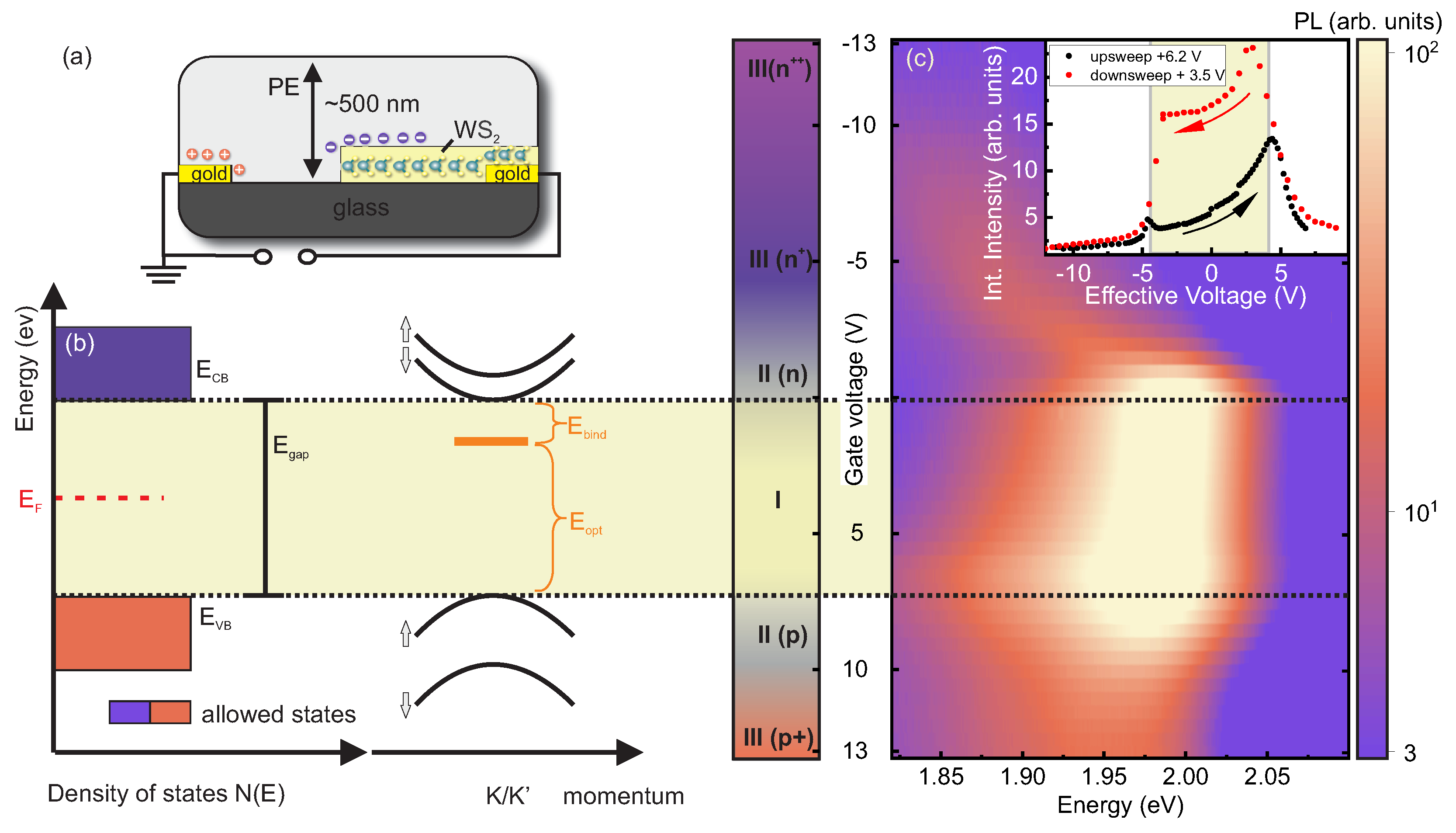
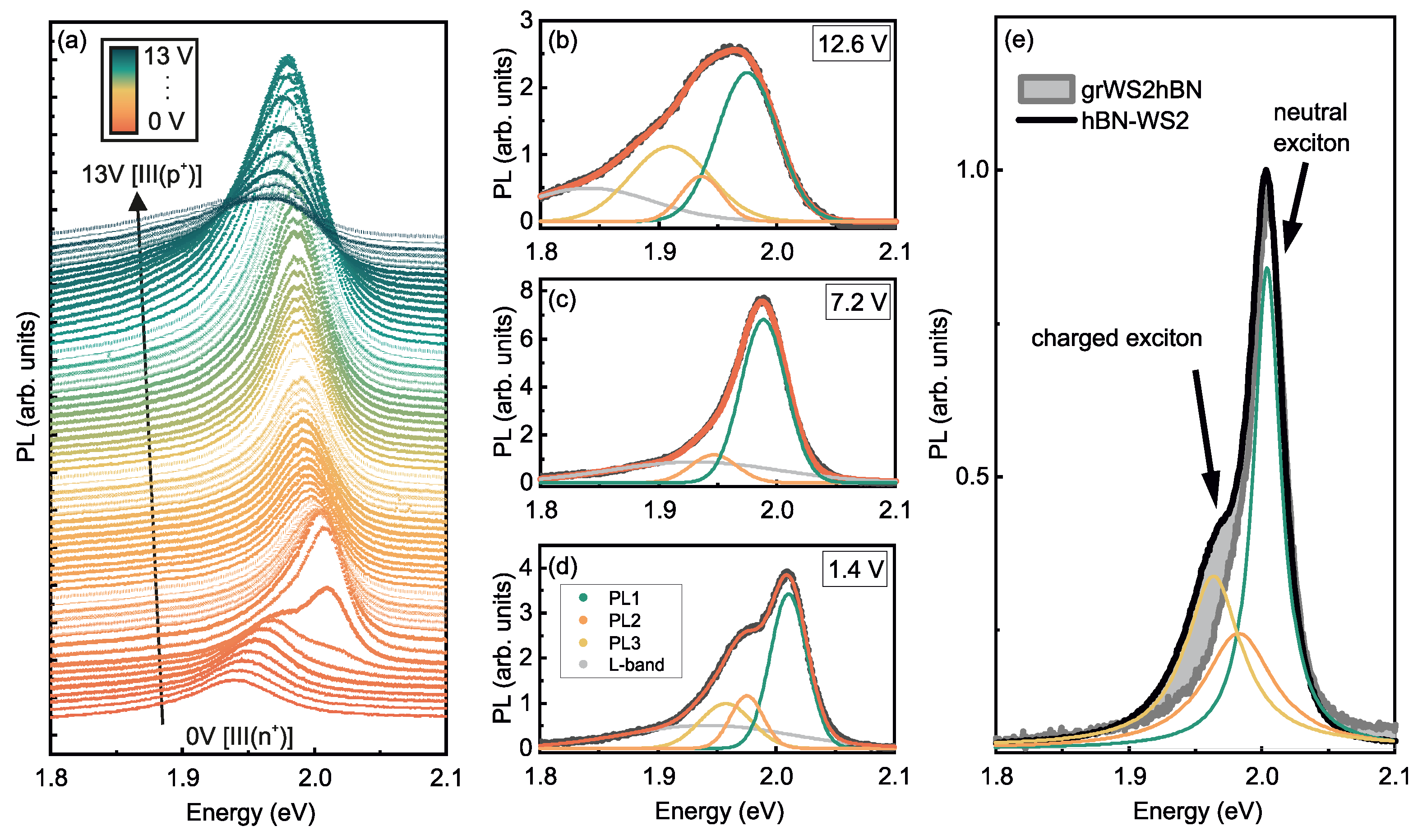

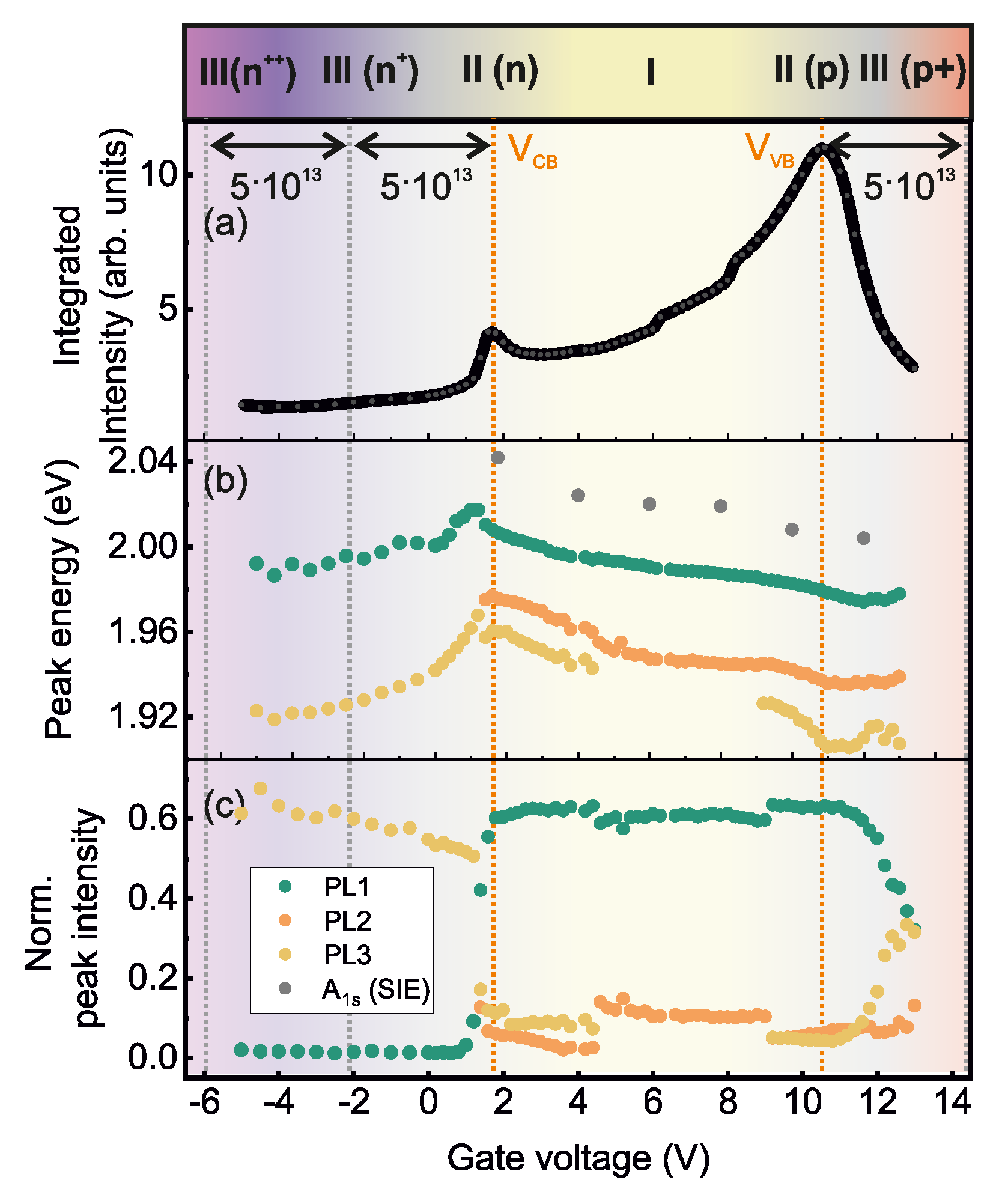
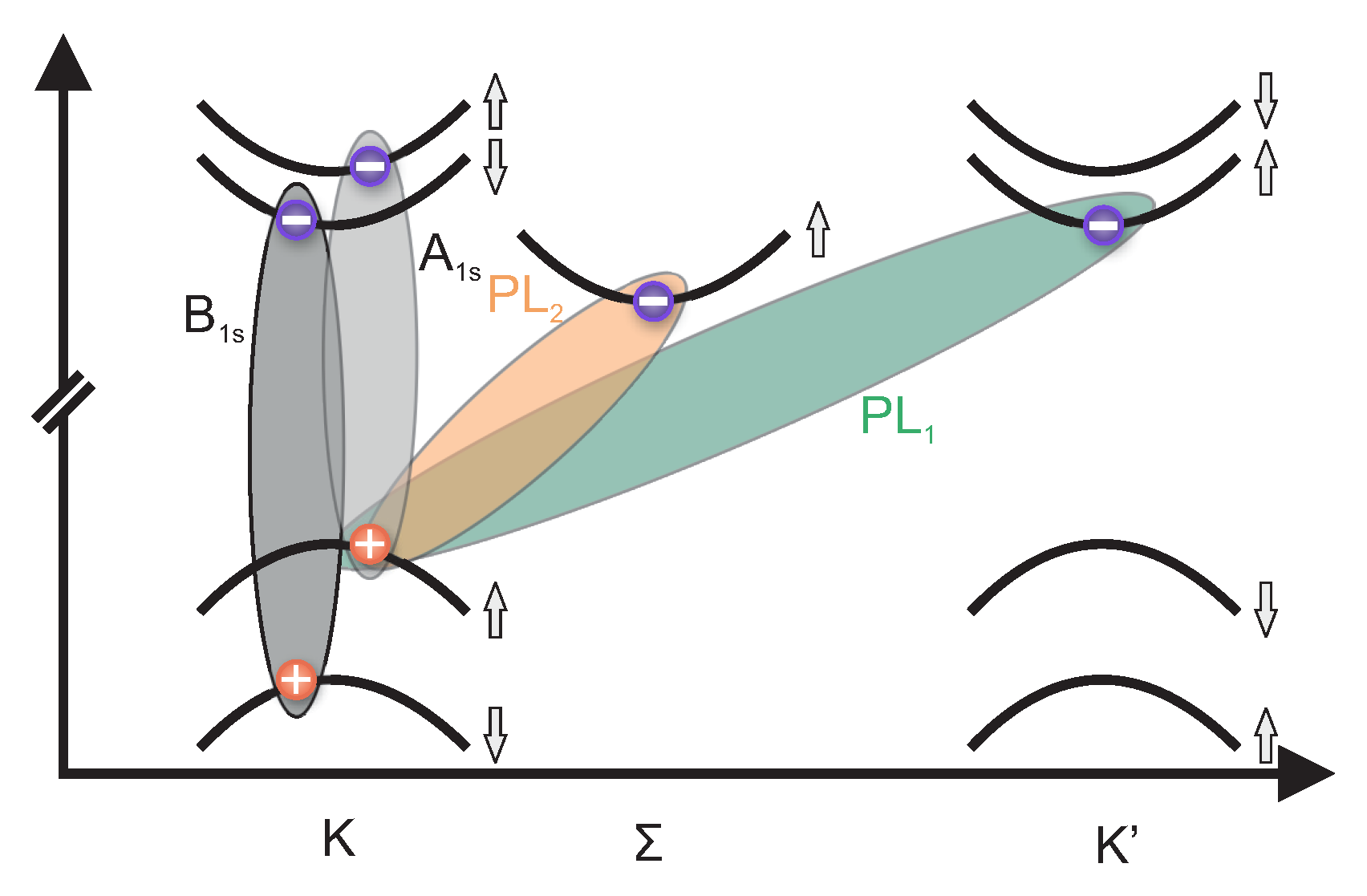
| /Doping | (eV) | PL1 (eV) | PL2 (eV) | PL3 (eV) |
|---|---|---|---|---|
| 5 cm) | - | 1.99 | 1.95 | 1.92 |
| 2.04 | 2.01 | 1.975 | 1.96 | |
| 2.03 | 1.99 | 1.95 | - | |
| 2.01 | 1.98 | 1.94 | 1.92 | |
| 5 cm) | - | 1.98 | 1.94 | 1.91 |
Publisher’s Note: MDPI stays neutral with regard to jurisdictional claims in published maps and institutional affiliations. |
© 2022 by the authors. Licensee MDPI, Basel, Switzerland. This article is an open access article distributed under the terms and conditions of the Creative Commons Attribution (CC BY) license (https://creativecommons.org/licenses/by/4.0/).
Share and Cite
Tiede, D.O.; Saigal, N.; Ostovar, H.; Döring, V.; Lambers, H.; Wurstbauer, U. Exciton Manifolds in Highly Ambipolar Doped WS2. Nanomaterials 2022, 12, 3255. https://doi.org/10.3390/nano12183255
Tiede DO, Saigal N, Ostovar H, Döring V, Lambers H, Wurstbauer U. Exciton Manifolds in Highly Ambipolar Doped WS2. Nanomaterials. 2022; 12(18):3255. https://doi.org/10.3390/nano12183255
Chicago/Turabian StyleTiede, David Otto, Nihit Saigal, Hossein Ostovar, Vera Döring, Hendrik Lambers, and Ursula Wurstbauer. 2022. "Exciton Manifolds in Highly Ambipolar Doped WS2" Nanomaterials 12, no. 18: 3255. https://doi.org/10.3390/nano12183255




